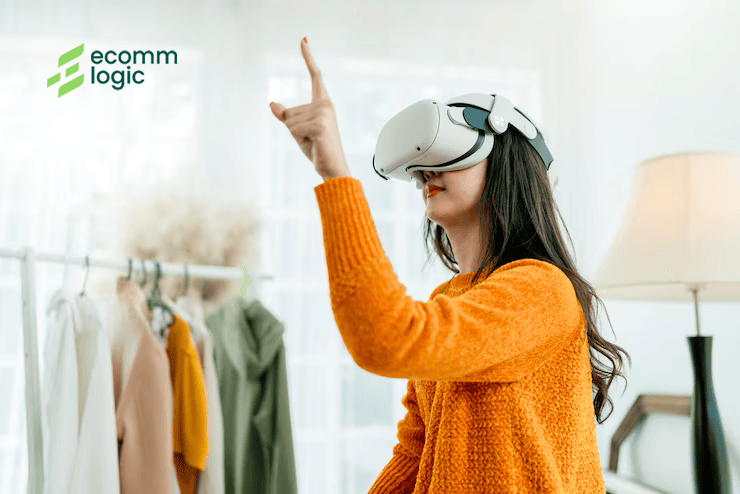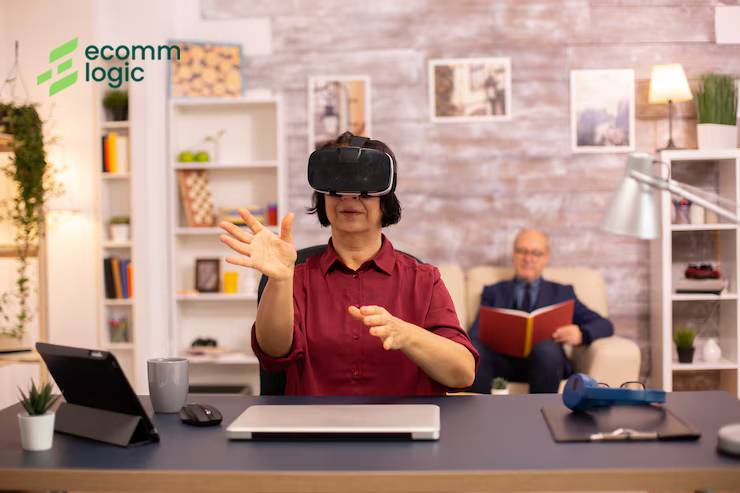The world of e-commerce is constantly evolving, with new technologies making it easier for consumers to shop online and for businesses to meet their needs. Among the most exciting advancements in recent years are Augmented Reality (AR) and Virtual Reality (VR).
These immersive technologies are reshaping how we interact with products and services, offering an entirely new dimension to the shopping experience.
In this blog, we’ll explore the growing role of AR and VR in e-commerce and how they are transforming the way consumers shop and businesses sell.
What is AR/VR and How Do They Work?
Before diving into their applications in e-commerce, let’s briefly look at what AR and VR actually are:
- Augmented Reality (AR) overlays digital information, such as images or sounds, onto the real world. Users can interact with these elements using smartphones, tablets, or AR glasses, enhancing their perception of their environment.
- Virtual Reality (VR) immerses users in a fully virtual environment, typically requiring a VR headset. This technology simulates a 3D space, where users can experience an entirely different world or scenario, providing a completely immersive experience.
In the context of e-commerce, these technologies are used to bridge the gap between online shopping and the in-store experience, offering a more interactive and engaging way for customers to explore products.
How AR/VR Enhance the Shopping Experience
- Try Before You Buy: Virtual Fitting Rooms
One of the most significant hurdles in online shopping has always been the inability to physically touch or try products before purchasing. AR is solving this problem with virtual fitting rooms and product try-ons.
For example, beauty brands are using AR to allow customers to virtually try on makeup using their phone’s camera. Similarly, furniture companies like IKEA have developed apps that let shoppers see how a piece of furniture would look in their home before making a purchase.
This virtual try-before-you-buy feature not only saves time but also reduces the uncertainty that comes with online shopping, enhancing customer confidence in their purchase decisions.
- Product Visualization: See It in 3D
AR and VR can help customers visualize products in a 3D space. This is particularly useful for industries like furniture, real estate, and fashion. AR allows customers to see how an item fits into their existing environment or how it would look from different angles.
For instance, fashion retailers can use VR to create a 360-degree view of their clothing items, allowing shoppers to see how garments will look from every angle. Similarly, home improvement and décor brands can use AR to show how products like lighting or appliances will blend with existing room settings.
- Interactive Shopping Experiences
VR is being used to create fully immersive virtual stores where customers can browse, interact with products, and make purchases as if they were in a physical store. These virtual storefronts can be accessed from home, offering the comfort and convenience of online shopping with the excitement and immersion of a brick-and-mortar experience.
Brands like Tommy Hilfiger have already experimented with VR to create interactive fashion shows, allowing customers to attend runway events from the comfort of their own homes. This type of engagement offers customers a unique, memorable experience that goes beyond typical online shopping.
- Improved Customer Engagement and Personalization
AR/VR technology can also play a key role in personalizing the shopping experience. By using AR to track a customer’s preferences or behavior within a virtual store, businesses can tailor the shopping journey to the individual. For example, an e-commerce platform could use VR to recommend products based on past behavior or integrate AR to help shoppers find products that match their specific needs.
By providing customers with a more personalized, immersive, and engaging experience, businesses can build stronger relationships and increase customer loyalty.

The Benefits of AR/VR in E-Commerce
- Increased Conversion Rates
By enhancing the shopping experience with AR/VR, businesses can reduce cart abandonment rates and increase conversion rates. When customers are able to see and experience products more clearly, they are more likely to make a purchase.
- Reduced Return Rates
With AR/VR helping customers make more informed decisions, they are less likely to return products. Virtual try-ons and visualizations reduce the risk of purchasing the wrong item, leading to fewer returns and saving businesses both time and money.
- Stand Out in a Competitive Market
As AR/VR technologies become more mainstream, incorporating these features into your e-commerce platform can help differentiate your brand from competitors. Offering innovative, engaging experiences will attract customers and position your brand as a leader in the industry.
- Cost Savings
While AR/VR development may seem like an expensive investment, the long-term benefits outweigh the costs. These technologies reduce the need for physical stores, lower overhead costs, and help businesses reduce the number of returned items — all of which can lead to cost savings.
The Future of AR/VR in E-Commerce
The potential of AR and VR in e-commerce is just beginning to be tapped. As these technologies continue to evolve, we can expect even more advanced features, such as haptic feedback (which adds a sense of touch to virtual environments) and more sophisticated AI integration to further enhance personalization.
E-commerce businesses that integrate AR/VR today are positioning themselves for success in the future. As customer expectations continue to rise, offering immersive and interactive shopping experiences will be key to staying ahead of the curve.
Conclusion
AR and VR are not just buzzwords; they are transformative technologies that are changing the face of e-commerce. By enhancing the shopping experience, offering virtual try-ons, and creating immersive environments, these technologies are helping businesses meet the ever-growing demands of today’s customers. The future of online shopping is immersive, personalized, and engaging, and AR/VR will undoubtedly play a central role in shaping that future.
At EcommeLogic, we are excited to see how these innovations continue to enhance the e-commerce landscape. Stay ahead of the curve, and start exploring the possibilities of AR/VR in your business today!

